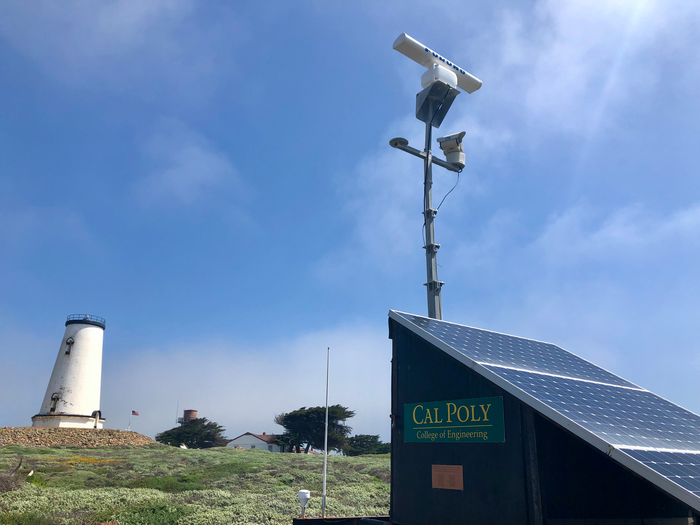Reviewed by Alex SmithAug 3 2022
A new research study discovered that boaters usually gather along the boundaries of marine protected areas (MPAs) off the Californian coast. These new results put forward that fishers are mindful of the MPA edges and gather just outside them to take advantage of better fishing opportunities by “fishing the line.”
 Marine Monitor (M2) Radar System monitored activity near the Piedras Blancas Light Station in central California. Image Credit: ProtectedSeas
Marine Monitor (M2) Radar System monitored activity near the Piedras Blancas Light Station in central California. Image Credit: ProtectedSeas
The research employed the ProtectedSeas Marine Monitor (M2)—an independent data collection tool—to constantly watch vessel activity throughout the day and every day of a week for one year in the proximity of five state-managed MPAs around Santa Barbara, San Diego, and Cambria.
The study was published in PLOS ONE. The M2 systems, which integrate custom software to marine radar, were used to record the motion of boats on the water. This enables scientists to quantify boat activity uninterruptedly, for the first time, in and around MPAs.
ProtectedSeas and site partners centered at each location manage the network of M2 systems in California.
The scientists observed specific boat activities and identified that a total of 40% more boating activity took place near MPAs in comparison to the neighboring areas. The “spillover” of marine life from within an MPA into the adjoining areas is a well-documented benefit of MPAs.
Most activity occurred at or beyond MPA edges, and not within the area itself. This suggests that boaters are aware of the MPA and that the areas are serving their purpose of creating safe refuges for ocean life regeneration. Fishers see a benefit from spending time near the area because MPAs are working.
Samantha Cope, Study Lead Author and Researcher, ProtectedSeas
The scientists discovered that boating movement clustered at the edges of MPA at all five sites. Clustering increased at the southern California MPAs in both recreational and commercial spiny lobster seasons, a valued fishery in the state. Also, clustering was 30 times more apparent at the Campus Point State Marine Reserve near Santa Barbara in the commercial spiny lobster season.
Conservation work needs to be driven by data, and M2 helps us understand trends in what's happening in MPAs.
Jess Morten, Study Co-Author and Researcher, California Marine Sanctuary Foundation
Morten is also a site partner with M2 in California.
Californian MPAs mainly limit fishing activities to preserve valuable species and habitats. While fishing activity is more at MPA edges, it recommends that fish may be ampler nearer the MPA in comparison to anywhere else in the local area.
Keeping a check on human movement can aid managers in verifying both the environmental and community advantages of the MPA, finding patterns in boat movement and other human benefits, and ensuring that MPA regulations are being followed.
For recording activity uninterruptedly, the M2 system offered scientists an autonomous approach.
We specifically designed M2 to monitor important marine places at a cost that was realistic for local managers. This research shows that M2 is an accessible and robust tool for monitoring MPAs.
Brendan Tougher, Study Co-Author and M2 Product Manager, ProtectedSeas
The state's first MPA Decadal Management Review is now underway to assess the current network of MPAs. For assessing the efficiency of existing ocean protections, examining human movement around MPAs is crucial.
With six in California and several others employed across the globe in developing countries, there are now 18 active M2 systems internationally.
“As a 'low-tech' solution for more efficient MPA monitoring, M2 is especially valuable for anyone with limited technical experience or resources since people can be quickly trained on how to use and interpret data from our systems,” stated Tougher.
At MPA boundaries, hot spots of the activity occurred. Generally, this activity was most prevalent during weekends and at mid-day. Possibly owing to its remote location, there was minimal activity all along at the location in central California that observed the Piedras Blancas State Marine Reserve and State Conservation Area. However, hot spots at MPA edges still exist.
Journal Reference:
Cope. S., et al. (2022) Coastal radar as a tool for continuous and fine-scale monitoring of vessel activities of interest in the vicinity of marine protected areas. PLOS ONE. doi.org/10.1371/journal.pone.0269490.